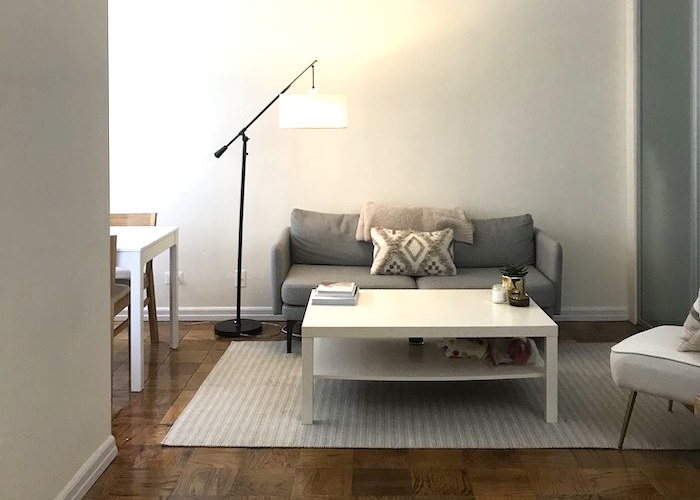How An Overpriced Yoga Membership Actually Saved My Finances

Yoga kind of saved my finances. That might sound like a strange sentence to read or say aloud —it certainly is a strange sentence to think and write — but when I found myself in credit debt and constantly withdrawing from my checking account in attempts to pay off said debt, I knew something in my life had to change.
A yoga membership typically costs upward of $100. Before joining a studio, I felt like I didn’t have any hobbies or any time to myself. My daily routine was to wake up groggily, commute, work, commute, and sleep groggily. It was boring and meant my eyes constantly stared at a blue screen. Whether it was my laptop or my phone, I was perpetually digitally attached. It started sucking the life out of me. It gave me headaches. I felt bleary. Scrolling was my only semblance of a social life. Before long, I realized I needed to institute a set time during each day to slow down. I needed, for my health and happiness, to be unplugged for a while. It was time to commit to a yoga studio.
So I joined one, and suddenly, I was chanting and OM’ing out loud three times to close my practice and churning out downward dogs like one of those Instagram influencers under the hashtag #YogaEveryDamnDay. But one thing consistently haunted me during my not-so-peaceful meditations. Could I technically afford to be here?
No, $100 is not a ridiculous amount of money, but when you’re struggling financially, trying to settle your debts, and attempting to bulk up your savings account for an emergency fund, a $100 yoga membership is probably one of the first (and easiest) things to cut.
But I loved it. And it was good for me. So as I grappled with my reasoning for joining inside my own head, I maintained that this was for my health. Without yoga, I would feel purposeless again, like my life was a series of doing things — working and commuting — just to get by, just to get to the next day, and just to make enough money to sustain a little longer.
I would cringe every first of the month as my yoga studio auto-withdrew the payment from my account. Would there be enough money in there? What would be left in my account? Sometimes I would muster enough courage to actually check my balance, and it would be as low as $50. That made it hard to justify. It also made it hard to enjoy, as the reason I was there was to combat stress, yet the expense of it was causing so much more stress and anxiety. But still, I argued with myself, if I don’t have this hobby, I won’t have any hobby; if I don’t do this practice, slow my heart rate down every day, and focus on my wellness and self-care, I will be significantly worse off.
With a fighter’s attitude and an unwillingness to give up my new passion, something had to be done. I started thinking: What do I have to adjust in order to justify paying for this membership? Where else could I cut?
I couldn’t cut my phone or commute, which were two of my biggest expenses. I certainly couldn’t cut rent. There was no other place to cut, but every area of my imaginary budget still needed monitoring. It was time, at 24 years old, to set up a budget and abide by it. It was time to stop being terrified of logging into my banking app. It was time to be an adult, which was way overdue.
It became much easier to enjoy a yoga class, anxiety-free, when I could stop worrying about what number was in my bank account. Having a budget, checking my balance often, and staying on top of my finances might seem like small, obvious things that every financially-independent person should innately do, but for me, they were significant steps. I was always afraid of money, but also very careless with it, simultaneously. I never liked being told I couldn’t afford to go to brunch or a yoga class, so I spent frivolously and then felt deep shame when I ended up with nothing.
Now when I meditate, I’m not bombarded by thoughts about how I don’t deserve to be on that mat, working on my self-care. I’ve stopped doing the math, and thinking about how much each minute of the class is costing me, and how many dollar signs fly out the window as I settle back into child’s pose. That shame is gone.
I’m paying off my debts, a little bit at a time, and I finally understand where I can be flexible (financially), and where I need to tighten my budget. There is no more overreaching in drastic and unmanageable attempts to pay off my debt. Monitoring my finances more closely left me with a cushion in my checking account, so I no longer worry about overdrafting. When I meditate, I now think: May I be happy. May I be well. May I be safe. May I be peaceful and at ease.
This chant applies to nearly every area of my life, but I apply it to my finances, too, as I sit cross-legged on my mat. May I be happy. (That means not stressing about money.) May I be well. (That means doing the things I need to do to be healthy.) May I be safe. (That means feeling financially secure.) May I be peaceful and at ease. (That means not stressing about what’s in the bank.)
May your finances make you feel happy, well, safe, peaceful, and at ease. Namaste.
Stephanie is a chai tea enthusiast with a special penchant for telling apart the Sprouse twins. She works as a social media editor in the magazine industry and blogs about all things lifestyle at StephOsmanski.com. Her words have been featured on Seventeen, USA Today, Parents, J14, and more.
Image via Unsplash




